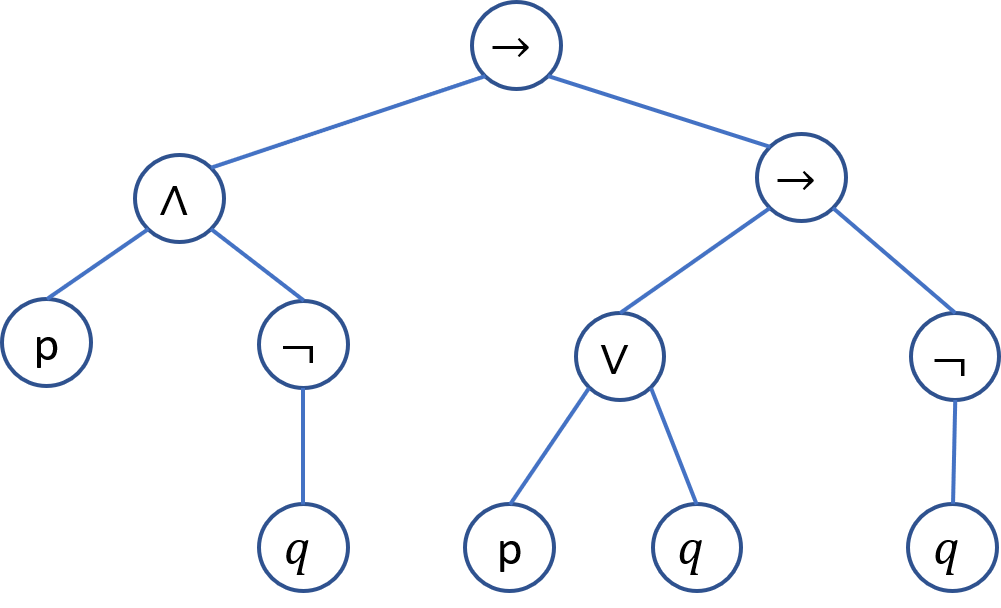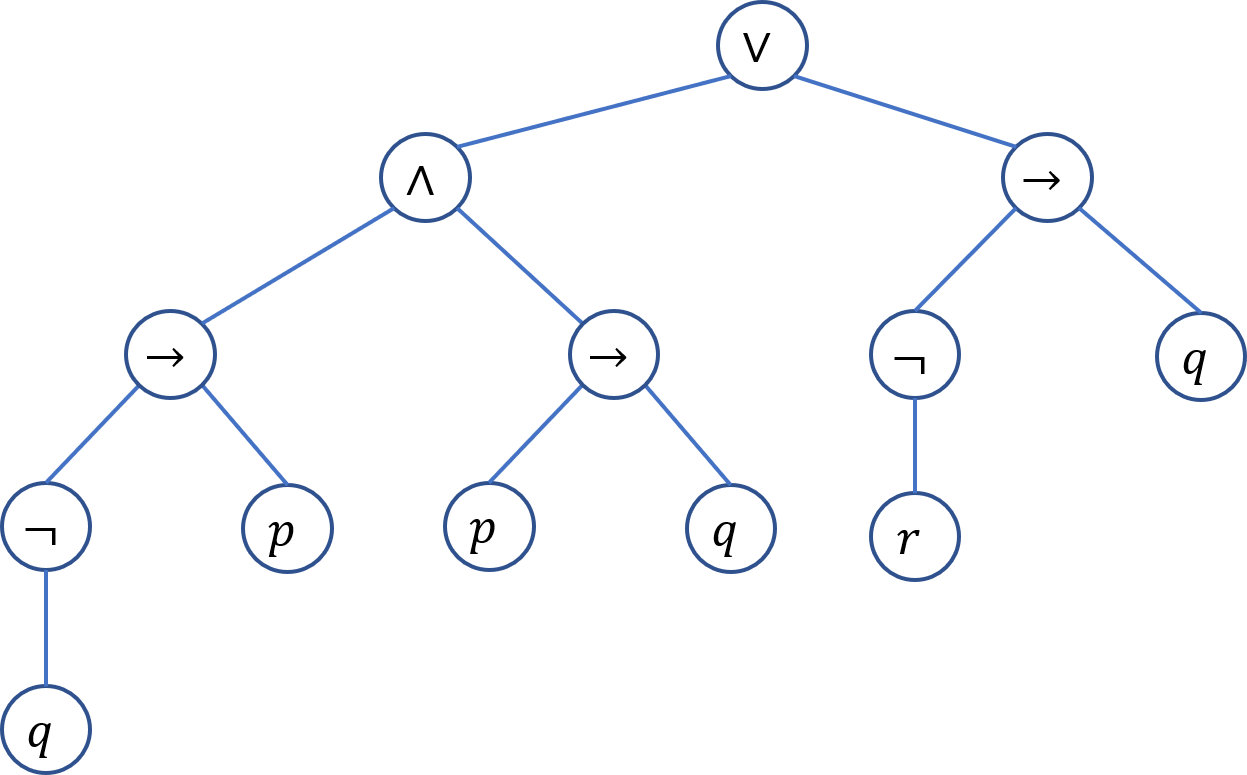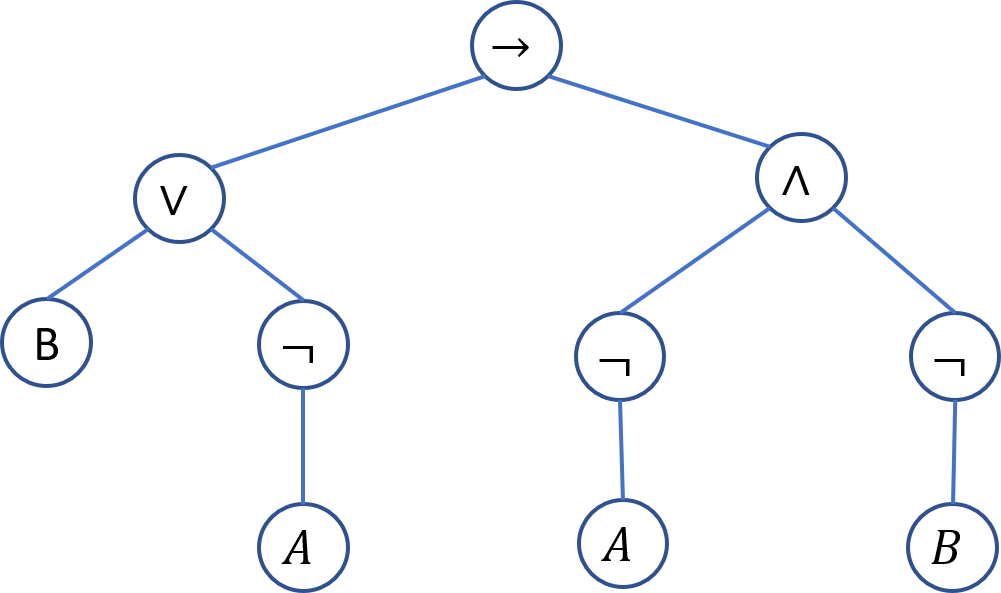- Remember the order of precedence: $p \to q \vee r \wedge \neg s$ is fully parenthesized $p \to (q \vee (r \wedge (\neg s)))$.


$ (p \wedge (\neg q)) \to ( (p \vee q) \to (\neg q))$
$( ((\neg q) \to p) \wedge ( p \to q) ) \vee ((\neg r ) \to q )$
$p$
$q$
$\neg q$
$p \wedge (\neg q)$
$p \vee q$
$ (p \vee q) \to (\neg q)$
$ (p \wedge (\neg q)) \to ( (p \vee q) \to (\neg q))$
T T F F T F T
T F T T T T T
F T F F T F T
F F T F F T T
$p$
$q$
$r$
$\neg q$
$\neg q \to p$
$p \to q$
$(\neg q \to p) \wedge (p \to q)$
$\neg r$
$\neg r \to q$
$(\neg q \to p) \wedge (p \to q) \vee (\neg r \to q )$
T T T F T T T F T T T T F F T T T T T T T F T T T T T T F T T F F T T T T F T T F T T F T T T T T T F T F F T T T F T T F F T T F F F T F F F F F T F F F F T T
$(p \wedge (\neg q)) \to ((p \vee q) \to (\neg q))$
$\equiv (p \wedge (\neg q)) \to ( \neg (p \vee q) \vee (\neg q)) $ Definition of $\to$
$\equiv (p \wedge (\neg q)) \to ( (\neg p \wedge \neg q)\vee (\neg q)) $ De Morgan's law
$\equiv (p \wedge (\neg q))\to ( (\neg q) \vee ((\neg p) \wedge (\neg q))) $ Commutativity
$\equiv (p \wedge (\neg q)) \to ( (\neg q) \vee ((\neg q) \wedge (\neg p)) $ Commutativity
$\equiv (p \wedge (\neg q)) \to ( \neg q) $ Absorption
$\equiv \neg (p \wedge (\neg q)) \vee (\neg q) $ Definition of $\to$
$\equiv (\neg p \vee \neg (\neg q)) \vee ( \neg q) $ De Morgan's law
$\equiv (\neg p \vee q) \vee ( \neg q) $ Double negation
$\equiv \neg p \vee (q \vee ( \neg q)) $ Associativity
$\equiv \neg p \vee TRUE) $ Definition of TRUE
$\equiv TRUE $ Identity
$( ((\neg q) \to p) \wedge ( p \to q) ) \vee ((\neg r ) \to q )$
$ \equiv ( (\neg (\neg q) \vee p) \wedge (p \to q) )\vee ((\neg r ) \to q ) $ Definition of $\to$
$ \equiv ((q \vee p) \wedge (p \to q) ) \vee ((\neg r ) \to q ) $ Double negation
$ \equiv ((q \vee p) \wedge (\neg p \vee q)) \vee ((\neg r ) \to q ) $ Definition of $\to$
$ \equiv ((q \vee p) \wedge (q \vee \neg p)) \vee ((\neg r ) \to q ) $ Commutativity
$ \equiv (q \wedge (p \vee \neg p)) \vee ((\neg r ) \to q ) $ Distributivity
$ \equiv (q \wedge TRUE) \vee ((\neg r ) \to q ) $ Definition of TRUE
$ \equiv q \vee ((\neg r ) \to q ) $ Identity
$ \equiv q \vee (\neg(\neg r ) \vee q ) $ Definition of $\to$
$ \equiv q \vee (r \vee q ) $ Double negation
$ \equiv q \vee (q \vee r ) $ Commutativity
$ \equiv (q \vee q) \vee r $ Associativity
$ \equiv q \vee r $ Idempotence
